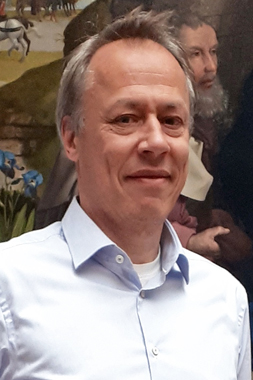Speakers
 Stephan Kemperdick
Stephan Kemperdick
Curator of the exhibition
Dr. Stephan Kemperdick studied fine arts at the Kunstakademie Düsseldorf 1983-87 and art history at the Free University Berlin. He graduated in 1992, and obtained his Ph.D. in 1996. He was assistant curator at the Städel Museum in Frankfurt and researcher at the Gemäldegalerie Berlin. In 2005 he became curator of old masters at the Kunstmuseum Basel and since 2008 he is curator of early Netherlandish and early German paintings at the Gemäldegalerie in Berlin.
 Nelleke de Vries
Nelleke de Vries
Speaker
Nelleke de Vries is Curator of Old Masters and Modern Art at Rijksmuseum Twenthe in Enschede, the Netherlands. Previously, she has worked at Stedelijk Museum Alkmaar, the RKD, and the Gemäldegalerie der Staatliche Museen in Berlin. Between 2018 and 2021, she was a doctoral researcher at the Institut für Kunstgeschichte of the Ludwig-Maximilians-Universität in Munich and member of the ERC-funded project SACRIMA: The Normativity of Sacred Images in Early Modern Europe.
Lecture abstract: ‘Ein verschollenes Original des Hugo van der Goes’. An Interpretation of Early Netherlandish Copies of the Adoration of the Magi
Compositions of Hugo van der Goes were highly sought-after shortly after their conception, which resulted in a multitude of copies. These can be divided into three leading compositions, namely the Lamentation, the Adoration of the Magi and the Death of the Virgin. The Berlin Gemäldegalerie owns examples from all three groups of copies, and the present exhibition brings together many examples from different collections. This talk will focus on a significant group of copies, of which one received the characteristic German title of Anbetung der Könige vor dem Stall im Hügel. Versions of this composition are nowadays attributed to Gerard David and Simon Bening, amongst others. Many elements in this particular composition are reminiscent of the pictorial inventions by Hugo van der Goes, and as such confirm the idea that there must have been an archetype by the artist himself. This talk will explore this composition and its appeal to artists during the fifteenth and sixteenth centuries, as well as questions of chronology and attribution.
 Till-Holger Borchert
Till-Holger Borchert
Speaker
Dr. Till-Holger Borchert was appointed director of the Suermondt Ludwig Museum in Aachen in 2021. From 2001 until 2021 he held several positions at Musea Brugge, including chief curator and Director General. He has (co-)curated numerous exhibitions on Early Netherlandish Art, including Van Eyck. An Optical Revolution in Ghent in 2020, and has published about this subject extensively.
Lecture abstract: Hugo van der Goes – Sources and Aftermath
The present exhibition is not only the first monographic show devoted to this exceptional artist, it also puts a remarkable group of followers of this intriguing master in the spotlight. This talk will look at possible collaborators of Hugo van der Goes and at some of his contemporaries in Ghent and Bruges, as well in Brussels and Leuven. Attention will be given to Van der Goes’ considerable impact on manuscript illuminators, their reciprocal influences will also be examined.
 Erik Eising
Erik Eising
Curator of the exhibition
Dr. Erik Eising studied Art History at Utrecht University where he graduated in 2011. He obtained his Ph.D. from the Johann Wolfgang Goethe-Universtät in Frankfurt in 2020 and joined the Städel Museum in the same city in 2017 as Assistant Curator of German, Dutch and Flemish Painting before 1800. Since 2020 he has been working as Assistant Curator at the Gemäldegalerie, Staatliche Museum zu Berlin, where he co-curated the exhibition Hugo van der Goes. Between Pain and Bliss.
